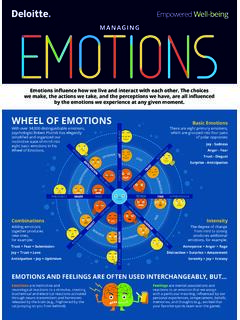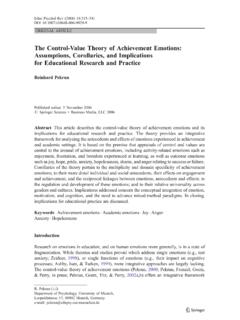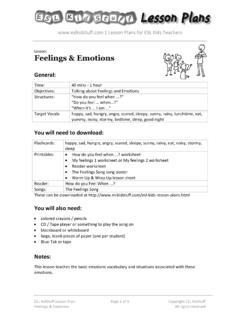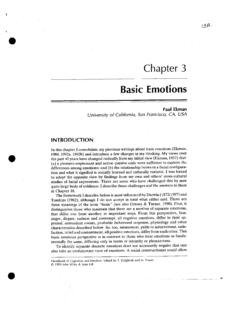Transcription of Copyright American Psychological Association
1 31 There can be no knowledge without emotion. We may be aware of a truth, yet until we have felt its force, it is not ours. To the cognition of the brain must be added the experience of the soul. Arnold BennettEmotion-focused therapy (EFT) can be defined as the practice of therapy informed by an understanding of the role of emotion in psychothera-peutic change. EFT is founded on a close and careful analysis of the mean-ings and contributions of emotion to human experience and change in psychotherapy. This focus leads therapist and client toward strategies that promotes the awareness, acceptance, expression, utilization, regulation, and transformation of emotion as well as corrective emotional experience with the therapist.
2 The goals of EFT are strengthening the self, regulating affect, and creating new Therapy, Revised Edition, by L. S. GreenbergCopyright 2017 by the American Psychological Association . All rights American Psychological AssociationEmotion-FocusEd thErapy4 CORE CONCEPTSEFT is a neohumanistic, experiential approach to therapy reformulated in terms of modern emotion theory and affective neuroscience. It is informed by humanistic phenomenological theories of therapy (Perls, Hefferline, & Goodman, 1951; Rogers, 1957), emotion and cognition theory, affective neuroscience, and dynamic and family systems theory (Damasio, 1999; Frijda, 1986; J.)
3 Pascual-Leone, 1987, 1988; Thelen & Smith, 1994; Weakland & Watzlawick, 1979). It views fundamental emotions like anger, sadness, fear, and disgust as foundational to the construction of complex frame-works that orient us to our environment. In addition, the emotional sys-tem is seen as the primary motivational system throughout life, essential to our survival and adaptation. emotions are seen as purposive and play-ing a key role in goal directed behavior. They have unique motivational and phenomenological properties and influence perception, cognition, and behavior (Izard, 1977).
4 Since its inception decades ago as an approach to how people change in different episodes in psychotherapy (Rice & Greenberg, 1984), EFT has evolved into a full-blown theory of functioning and practice that proposes that emotional change is central to enduring change. EFT is premised on the belief that traditional psychotherapy has overemphasized conscious understanding and cognitive and behavioral change to the neglect of the central and foundational role of emotional change in these processes. Although it does not deny the importance of the creation of meaning and behavioral change, EFT emphasizes the importance of awareness, accep-tance, and understanding of emotion; the visceral experience of emo-tion in therapy; and the importance of changing emotion in promoting psychotherapeutic posits that emotions themselves have an innately adaptive poten-tial that if activated, can help clients reclaim unwanted self-experience and change problematic emotional states and interactions.
5 This view that emotion, at its core, is an innate adaptive system that has evolved to help people survive and thrive has garnered extensive empirical support. emotions are connected to our most essential needs (Frijda, 1986). They rapidly alert us to situations important to our well-being, by giving us Copyright American Psychological AssociationIntroductIon5information about what is good and bad for us by evaluating whether our needs are being met. They also prepare and guide us in these important situations to take action toward meeting our needs. EFT views the indi-vidual as fundamentally affective in nature.
6 Emotion sets a basic mode of processing in action (Greenberg, 2015; LeDoux, 1996). Fear sets in motion a fear processing mechanism that searches for danger, sadness informs us of loss, and anger informs us of violation. emotions are also our primary system of communication, rapidly signaling our intentions and affect-ing others when expressed. As our primary meaning, communication, and action orientation systems, emotions determine much of who we are. Rather than I think, therefore I am, EFT is based on the idea that I feel, therefore I am and proposes that first we feel, and then we think, and we often think only inasmuch as we feel.
7 Thus, emotional change is seen as the key to enduring cognitive and behavioral are helped in EFT to better identify, experience, accept, explore, make sense of, transform, and flexibly manage their emotions . As a result, they become more skillful in accessing the important information and meanings about themselves and their world that emotions provide, as well as become more skillful in using that information to live vitally and adap-tively. Clients in therapy are also encouraged to face dreaded emotions to process and transform them. A major premise guiding intervention in EFT is that transformation is possible only when individuals accept themselves as they are.
8 EFT is an approach designed to help clients become aware and make productive use of their grew out of, and was a response to, the overemphasis on cognition and behavior in Western psychotherapy. It is easier to focus on cognitions than implicit emotions because they are more easily accessible to conscious-ness, and it is easier to try to change behaviors than automatic emotional responses because behaviors are more accessible to deliberate control. Emotion, however, exerts a key influence on cognition and behavior. EFT attempts to shift the focus by emphasizing the crucial role of the experience of adaptive and maladaptive emotion in therapeutic core feature of EFT practice is that it makes a distinction between conceptual and experiential knowledge and it posits that people are wiser than their intellects alone.
9 In an experiencing organism, consciousness is Copyright American Psychological AssociationEmotion-FocusEd thErapy6seen as being at the peak of a pyramid of otherwise nonconscious organ-ismic functioning. Experiments in directed awareness are used to help concentrate attention on as yet unformulated emotional experience, to intensify its vividness, and to symbolize it in awareness. In therapy, emo-tion is focused on as visceral experience and is accepted, as well as worked with directly, to promote emotional change. The articulation of emotion in narratives of being with self and others provides the story of our lives (Angus & Greenberg, 2011).
10 At the center of the approach is helping clients discern when they need to use adaptive emotion as a guide and be changed by its urgings, when they need to change maladaptive emotions , and when they need to regulate emotions that overwhelm them. A key tenet of therapy is that clients must experience emotion to be informed and moved by it and to make it acces-sible to change. Clients do not change their emotions simply by talking about them, by understanding their origins, or by changing beliefs; rather, emotions are changed after they are accepted and experienced, opposed with different emotions to transform them, and reflected on to create new narrative meaning (Greenberg, 2015).

















